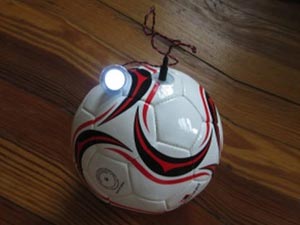Four Harvard grads invented a way to harness the energy of the world’s most popular sport with sOccket, a soccer ball that collects kinetic energy with every kick. We thought the idea was so clever we gave it a Breakthrough Award last year. Now, sOccket is ready to hit the ground in countries around the world this fall. We asked sOccket co-founder Julia Silverman about the team’s technology and how they plan to distribute 10,000 sOcckets to countries such as Mexico, El Salvador, Haiti, Costa Rica and Nigeria by the end of 2011.
Last year PopMech honored your prototype soccer ball. Now, you’re launching one for mass distribution. What’s different in the new version?
We have a whole new patent. While the first design was based on the inductive coil mechanism, like a shake-to-charge flashlight, this one is based on a gyroscopic mechanism. So instead of just capturing energy from one dimension of motion, it’s capturing energy from all possible dimensions of motion. It’s constantly going to be capturing energy with even the slightest movements. And because of that, we can capture a lot more power. For example, the first prototype could only power an LED lamp. Now we can power a large lamp with multiple LEDs, and also a water purifier.

What kind of increase of power are we talking about?
The new version employs our patent-pending “g-Kick” gyroscopic technology, which generates a maximum of 24 volts. The operating range of the battery in the new ball is 2.71 to 3.61 volts. The voltage is not constant, but we cultivate the power that’s generated in short bursts. The new ball’s battery also has special circuitry that limits the maximum and minimum charge so that the battery itself will last longer. In comparison with the old prototype, the average volts for the new sOccket design will be up to 1000 percent greater! We’re really excited.
What else did you learn from the original ball’s design?
During pilot testing, in Liberia, Nigeria and South Africa from summer 2009 through summer 2010, there were a lot of things that we found really wrong. That’s when we went back to the drawing board. One of our earlier issues was that, while the internal mechanism of the ball was pretty robust, the ball itself was not able to withstand the rough terrain of some of these resource-poor areas. Now the ball will be able to last beyond the internal mechanism and play can continue even beyond the lifetime of the technology.
We also really worked hard to cut down on weight, and worked hard to make it as close to a regulation-size soccer ball as possible. We worked on the playability, making sure the mechanics felt more like a regular soccer ball, and looked for greener materials. This ball is 95 percent recyclable.
What ways are you getting these to the developing communities that need them?
There are two ways that we distribute the balls. One is through partnerships with organizations on the ground, best-practice NGOs who are already established in and know the communities. And the second way is through sOccket innovation camps, which are also in partnership with these organizations. Right now, we’re starting with just 2500 sponsored balls. Beyond the 2500, we’re producing probably upward of 10,000 before the end of the year, minimum. Consumers will be able to buy the balls online in 2012 through a Buy One, Give One program, where they’re essentially donating a ball for distribution in developing areas. And nongovernment organizations can buy the balls at a wholesale price, so, even if they aren’t selected to be partners for the donation round, they can still buy the balls and incorporate them into their programs.
We decided to distribute in Mexico, Costa Rica, Haiti, El Salvador, and Nigeria first. Once the balls get on the ground, we’re not just going to leave them and say, “Okay, have fun.” We really want the balls to be built into the programming of these institutions, whether it’s a school or a sports group or a health group.
What was it like to see kids playing with the ball?
Seeing the communities playing with the ball—that is the best part. That’s why I do this. That moment where you see a kid plug in the light for the first time and his or her eyes light up and you can tell the wheels are turning, as they’re thinking, I can do something too. How can I be creative in my community? That’s the moment where all of the hours and everything make sense. Kids are so excited to play. It’s definitely rekindled my connection with my inner child. That, for me, is the best and most rewarding part of the project.
What do you see for the future of sOccket? Any other projects in the works for your company, Uncharted Play?
We definitely have very high hopes for the social side of our business. That’s really what means a lot to us. We also want to inspire innovation, and we want to make the end of 2011 and 2012 about getting as much done as possible. We’re trying to move manufacturing entirely to Nigeria, and start the first fair-trade manufacturing plant in that country, working to make our product socially responsible every step of the way.
As far as sOccket technology goes, we’re probably going to do basketball and other sports as well, just to cover different markets, like North America. We have other projects in the pipeline, in relation to the flagship sOccket project and also other things that capitalize on our motto of making fun functional.
Source: popularmechanics
 Follow
Follow